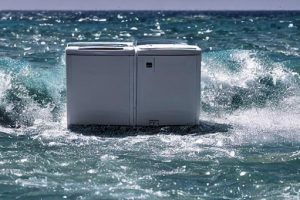
Microplastics are quite literally everywhere: in face creams and moisturizers, toothpaste, car tires, disposable water bottles, food, soil, air, and most notably—in our oceans and waterways. These tiny particles of plastic—no bigger than a speck of dust or a chia seed—have infiltrated almost all aspects of life. Though there is not yet a large body of data on how consumption of microplastics affects humans or other species, many scientists suspect they have the potential to be harmful.
According to a 2017 International Union for Conservation of Nature report, about 35% percent of the microplastics that enter the world’s ocean originate from a rather unexpected source: the washing of synthetic fabrics. Prominent clothing lines such as Patagonia and H&M tout their use of recycled fabrics as environmentally conscious. But considering that petroleum-based fabrics such as nylon, polyester, and acrylic comprise at least 60% of all clothing worldwide, is that true?
For her senior design project, Cristina De Jong, a materials science and engineering major at the Whiting School of Engineering, wanted to find out.
“We decided to look at the microplastic release of fabrics made from recycled materials and compare that to fabrics made from non-recycled materials to see if fabrics made from recycled materials are actually a viable solution or if they are actually contributing more microplastics through just laundry alone,” De Jong said.
To test this, De Jong and her team built and designed a steel mesh system that could filter wastewater from a portable, “apartment-sized” washing machine. They then set about sourcing fabric to test. Lauren Choi ’20, founder and CEO of The New Norm, a brand that creates clothing from recycled ocean plastics and red Solo cups, offered her product, as well as one not comprising recycled synthetics, for the experiment.
“We washed both of those fabrics, filtered them through the system that we’ve designed, and tried a couple different methods of quantification to figure out how many microplastics were being released by both types of fabric under a couple different parameters,” De Jong said. The winning method involved weighing the mesh filters to determine the amount of microplastics left behind by each wash.
De Jong says the preliminary results, though not entirely conclusive, surprised her.
“We expected the recycled fabrics to release much larger amounts of microplastics than those made without recycled materials. Though we don’t have enough data to say conclusively whether recycled fabrics on the whole produce more, the difference between them wasn’t statistically significant,” she said.
De Jong’s research also offers intriguing revelations on possible ways to mitigate the release of microplastic particles from synthetic clothing during consumer use. Her experiment involved subjecting each garment to multiple wash cycles, revealing that the highest microplastic emission occurred during the initial wash, regardless of whether the fabric was recycled or non-recycled. As a result, she suggests that implementing an industrial filtration system similar to the one employed by her team could be a proactive measure towards sustainability.
“Textile companies, or anyone producing garments made of synthetic materials, could do a primary wash, where they can filter out the microplastics before sending it out to consumers. That way, the responsibility is no longer on consumers to be worried about collecting microplastics or trying to figure out a filtration system for their own home,” she said.
De Jong and her team also found a difference in the amount of microplastics released during the regular and rapid-wash settings that many modern households use.
“The rapid wash produced much more microplastics than the regular wash. So that’s an interesting insight into whether you should use a gentle wash or a more ‘standard’ wash setting,” she said.